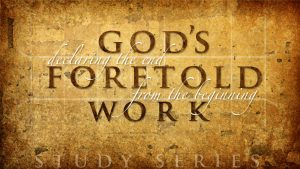[…] If ever there was an interpretation getting away with exegetical ‘murder’, it’s certainly preterism. They are forced to separate what God has joined. For example, it is exegetically impossible to separate the day of the Lord from the destruction of Jerusalem. The day of the Lord is the hope of Israel in the OT and the church’s hope of Christ’s return in the new. Orthodox preterists rightly recognize the NT’s references to the day of the Lord as still pertaining to the church’s ‘blessed hope’ of Christ’s return, but inconsistently deny its relation to the tribulation and Jerusalem for entirely dogmatic reasons. To do this, they must deny that the post-tribulational return of Christ described in the synoptics (MT 24; Mk 13; Lk 21) is connected with the church’s hope of Christ return, which, of course, the NT itself unambiguously identifies with the still future day of the Lord […]
The Little Horn, the Beast, Gog and Anti-Christ
[…] Yes, the ‘prince that shall come’ is indeed the ‘little horn’ that comes out of the fourth beast of Dan 7. But the same ‘litte horn’ (and I must insist that he is indeed the same on solid exegetical evidence) comes “no less” out of a division of the third kingdom (see 8:9). So I think it is a mistake to overly emphasize the ‘territorial’ aspects of the successive beast kingdoms, but to see rather the more generic, ‘organic’ nature of their relation. Notice that the kingdoms are not represented as ceasing to exist, but each lives on in its successor, so that at the end, all are destroyed at once as all existing at once. That’s what the language of the passages seem to represent. The kingdoms are viewed as unit, the beast-like kingdom of man. They are distinguished and identified according to their impingement on fate and fortunes of Israel as usurpers of the theocratic kingdom of David (Dan 2:44). I see them in a more ‘organic’ relation to the doctrine of the principalities and powers in chapter ten, the real ‘powers’ behind the kingdoms of this present evil age, and their defeat as the real issue of Israel’s restoration. But even on territorial grounds, Rome certainly included most of the eastern Arab lands that could produce a figure that could marshal the Islamic world against Israel. So I see Titus and the 70AD destruction of the temple and city as only a pre-typical fulfillment of a yet future destruction of city and sanctuary by the actual contemporary people of the Antichrist. […]
Jacob’s Trouble
[…] After establishing Jacob’s trouble as synonymous with a future Antichrist time of unequaled great tribulation, it would be helpful to trace the background of the concept in the larger history and goal of the covenant. This is key to showing its future significance, particularly as it relates to Israel. (The significance of Jacob’s trouble for the church has more particularly to do with the final victory of the remnant over Satan (Dan 11:32-35 with 12:1 and Rev 12:12). Of course the history of the concept of Jacob’s trouble begins with the crisis that Jacob faced upon his learning of the approach of Esau with four hundred armed men. This is the crisis of ultimate weakness that prepared Jacob for his desperate wrestling with the angel of the Lord’s presence at the ford of Jabbok. For Jacob, this was the ultimate, divinely appointed crisis that brought about the new priestly brokenness that would now distinguish the true “Israel” (one that has ‘power with God’) to be a priestly blessing to all peoples (Zech 8:23). […]
The Time of the Resurrection of Millennial Saints
[…] Leave it to me to write some pretty ambiguous things on the fly like that. I should be more careful to read over what I write before releasing it. No, I’m at no variance at all with Bickle or Art or any other “historic” premill (as distinguished from the pre-tribulational pre mill) on the time of the rapture and resurrection of the church at the ‘last trumpet’. I share that view exactly. I am also at one with all premillennialists that recognize that there will be millennial saints in their natural bodies after Christ’s return. Israel receives the grace of repentance and the pouring out of the Spirit AT the point of Christ’s return (the ‘day of the Lord’ Isa 27:13; 59:21; 66:8; Ezek 39:22-29; Zech 12:10; Mt 23:39; 24:29; Acts 2:20; 3:21; 1Thes 5:4). This is the same time that the living church is translated into glorified immortality (compare 1Cor 15:50-54 with Isa 25:8; 27:13). In other words, the same age transitioning, revelational event that translates and raptures us at the time of His appearing, becomes a transforming revelation of mercy to the surviving remnant of Israel. That’s why they go apart to mourn, while we take our place with Christ and the rest of the “spirits of just men made perfect” in positions of rule. However, I believe that like the angels, the perfected spirits of the glorified redeemed are unseen to the natural eyes of the inhabitants of the millennial earth. That’s my view, as this alone makes sense of any literal reading of many things that scripture shows to be happening at the same time. […]
When was the book of Revelation written?
[…] I’ve never studied the matter closely, probably because I can’t see where it would make a lot of difference. Sure, it’s a ‘make or break’ for preterism. They absolutely MUST defend the early date with all their might, and you know the power of a subjective interest. But that is only because they are content with a hodge podge of inconsistent exegesis. For example, if we make Nero the Beast, then how can we NOT make him Paul’s man of sin, which is obviously Daniel’s ‘willful king’ (11:36) ‘little horn’ (7:21) and beast (7:11)? Since this figure is clearly destroyed at no time short of Christ’s return (whether mystically or literally conceived), then you have a real problem, because Nero meets his ‘apocalyptic’ demise quite some time before Jerusalem is destroyed by Titus, (the other so-called return of Christ in ‘mystical’ apocalyptic judgment) some years later. So what’s wrong with this picture? Exegetically everything! The Beast is slain and the millennium of the martyred souls is believed to begin with the death of the Nero, the Beast, some years before the siege and fall of Jerusalem. It’s silly. In the real world of biblical exegesis, the brief tenure of the Beast’s career coincides with the final desolations of Jerusalem as perfectly concurrent . So early dating John’s Apocalypse assists nothing for the preterist’s cause. I have no problem with an earlier date, because I have no problem that the book might have had a very beneficial early circulation, bracing both Roman Christians in the north of the empire and Jewish Christians in the south for two very horrific but distinct periods of tribulation, both having much of the essence of the final tribulation that closes this age with the “actual’ return of Christ. […]
True Prophetic Authority
[…] The exercise of true prophetic authority assumes a depth of priestly identification. Thus it is that only one that has been processed through tribulation to become priestly (reflected in a brokenness of identification with human weakness) can be entrusted with true prophetic authority, which is far more than accurate preaching or even accurate prediction. Such authority comes by being “in touch” with God as God, which puts one in touch with man as man. This is why the prophets of the OT and the apostles of the NT were not only faithful to ” root out, and to pull down, and to destroy, and to throw down …” But also to build, and to plant. The first four belongs to the office of the law, and the last two belongs to the ministry of the gospel. A true gospel in balance with the whole counsel of God is hard to come by, just as true apostles and prophets are hard to come by. It seems to me that our only safe hope to recognize and distinguish the true from the false, is to deeply and truly know the Lord. This means we are personally exercised in the laws and patterns of His ways in our own lives. Otherwise, even our estimation and evaluation of what would count as “fruits” will be just as faulty as our knowledge of God. So, once again, the burden is on the priesthood of every believer. […]
Defining the “Apostolic”
Dear Reggie, Is it possible to pass on to me a concise plain speaking explanation of the word APOSTOLIC without losing too much of its meaning. Bless you. Shalom. The definitive paradigm for true apostleship is Isaiah (ch 6). The dynamics are all there. You will see it in the […]
Observing the Sabbath
[…] Paul makes this a matter of liberty and personal conscience, not to be judged by another. So you are free to use your Shabbat blessing as you choose, as a sweet offering to the Lord, and as refreshment to your soul, your family, and as many as are inclined to observe with you. It is unto the Lord that you regard the day; and He is honored by what’s in your heart. After all, the day was not made for its own sake, but for you. However, mark well that IF we were still under the law as a binding administration, this would not be so. It would then be a very particular matter indeed, and no part of all the appurtenances of Sabbath observance could be left undone without spoiling the whole. […]
The Deeper Conversion of the Converted
[…] Although knowing and appreciating Art’s meaning in that title, I used to tell him that it might have been more accurately entitled “FEW saved and even fewer converted,” that is, converted in the sense that Peter was ‘turned’ after the great blow to his presumption. I wrote an article entitled “the deeper conversion of the converted,” in which I showed the evidence that Peter was indeed regenerate (the common meaning attached to the word ‘converted’), but was not as yet completely ‘turned’ (broken and emptied of self-reliance) in the sense that Jesus uses the word in that instance. […]
In The Year That King Uzziah Died…
[…] I think what we’re reaching for here is to try to find something of the pattern or dynamic in Isaiah’s transforming vision from which all else followed. Is there a key? What manner of preliminary grace or deep dealings prepares the soil for such a divine in-breaking?
In traveling with Art and interacting with him over the Isa 6 message, I pointed out the significant analogy of Isaiah’s experience with Israel’s apocalyptic revelation when “they shall LOOK upon Me whom they have pierced” (Zech 12:10; Mt 23:39). This is, of course, the great day of the Lord when the Deliverer comes out of Zion to accomplish Israel’s final redemption. But there is more to this than the mere visible return of Christ. We must not neglect why this event has such a different effect on the beleaguered remnant than same event will have on the demonically driven nations. It is the element of gracious revelation; “the Spirit of grace and supplication.” Otherwise, the vision of the returning Lamb would be unbearable, as in the case of the mark bearing ‘earth dwellers’. […]





